Nicholas Knox and Mary Butler
Acknowledgement
This page was written and researched by Richard Knott. It is from his website 64 Regency Ancestors. It is an excellent history, and it is reproduced here with his kind permission. Please also bear in mind that the notes at the bottom of this article are his notes not mine.
Nicholas Knox (1812-1885) & Mary Butler (1812-1852)
Although his name suggests a Scottish past Nicholas Knox, like his father before him, was born in Devon. All the Knoxes earned their living from the sea, so it is not hard to imagine a Knox from a previous generation sailing South down the coast from his ancestral home, but any connection to Scotland was well in the past when Robert Knox married Elizabeth Berry in Brixham in 1809.
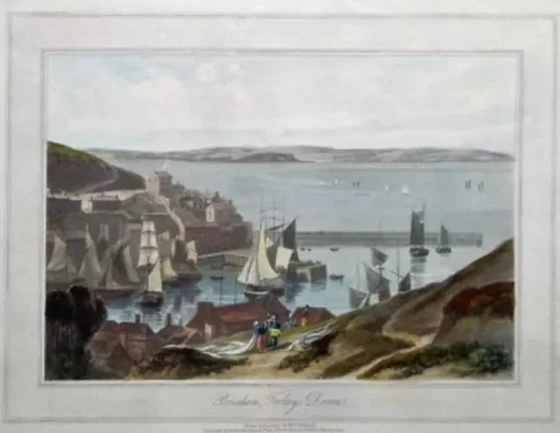
Brixham
For many years Brixham had been the leading fishing port in England with nearly a hundred trawlers landing over 120 tons of turbot and sole each week. Unlike some nearby ports, it did not have a natural harbour but it was sheltered from the winds, so the smacks could get enter and leave in most weathers. Towards the end of the previous century it had developed the distinctive fishing smack which, together with the drift net trawling that they used, had brought fishermen from miles around to work in Brixham. Many of the boats fished along the South coast but increasing numbers ventured further afield. Before the end of the 18th century they were fishing off the East coast and about the time that Nicholas was born, Brixham boats were in the Irish Sea near the coast of Ireland. Previously the fish had provided a cheap and plentiful diet for local people but, as rarer and more interesting fish were found further away, Brixham fish were starting to supply Bath, Exeter and London, with the higher prices making those markets more attractive than the local ones.
For many fishermen Brixham was only a fishing area in the summer. In October many would leave for other areas, such as Dover, and take their catch directly to London. Even those that went as far as Harwich, Lowestoft and the Dutch coast would still return to Brixham later in the year but, at about the time that Robert and Elizabeth married, the fishermen started to settle permanently in other places. There is no way of knowing where Robert fished, but he stayed in Brixham until about 1815. Fishing was not a glamorous occupation; it was hard work, dangerous, and offered no future except more of the same. Most of the money needed to be made in the summer months, and families would often own a shared boat, so success or failure came to all at once. Should a trawler sink, then often several men from the same family died in the same tragic event. Robert was either lucky or skilled, but there is no evidence of a crisis, and he continued to bring in the fish that his wife would then sell.
Plymouth
Some time between 1815 and 1818 the couple, with their three young children, moved thirty miles along the coast to Plymouth, just too late to witness Napoleon arriving on his way to imprisonment on Elba. Why they should do this is not clear. Brixham was still the most successful fishing port and, while fishermen were setting up trawling centres further and further away from their home base, Plymouth, an established fishing port, did not fall into that category. The town – really three towns still – was suffering the consequences of the end of the Napoleonic War with hundreds of men laid off from the docks. And yet the town was still growing. It had long since expanded beyond its walls and the gradual knocking down of the old city gates during the 18th century had encouraged the richer merchants to move outside the old town. New streets sprung up everywhere and the Theatre Royal which had been criticised for being built in the middle of nowhere fifty years earlier, was now surrounded by houses
A fisherman would not have lived in this part of the town, but in the small narrow streets close to the harbour called the barbican. For centuries this had been the site of the fish market and most of the fishermen lived in the houses nearby. The area was not exclusively concerned with fishing – the Black Friars Distillery, for instance, had been set up nearby in 1793 in a former monks house and Plymouth Gin would be brewed there until the present day – but the smell of fish would have been very evident as the children grew up close to where their father landed his catch.
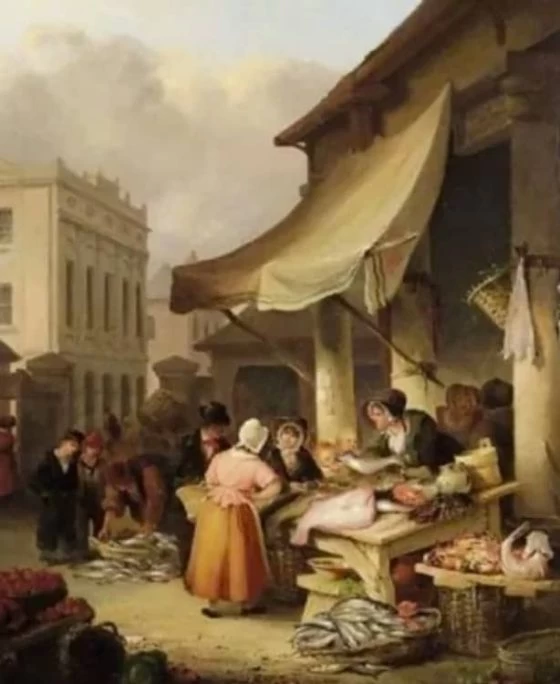
As Robert and Elizabeth were arriving in Plymouth, a report was being prepared by William Burt on Plymouth’s fishing industry. (Note 1) In it he refers to the strength of the pilchard catch over the centuries and the ‘conger, hake, ling…’ that were plentiful off the Plymouth coast. Twenty-seven or twenty-eight trawlers (smacks) fished out of the port, each, in general, carrying ‘…two trawls, two men, two boys (apprenticed to the owners) and catch soles, plaise, hake, haddocks, turbots, red mullet, kite, brill, or hallibut, pipers, tubs, and other fish to the value of £600 each…(sic)’. There was an agreement that any money received for the fish would be divided into seven: the owner of the boat would get two and a half shares, the captain another half (sometimes the same person) and the others would divide the rest. In summer the boats would go out on every tide but, in the winter, most fisherman would stay out from Monday until Wednesday and sell their catch for people in Bath and Bristol. The cost of all the fishing equipment meant that fishing was not a lucrative industry but, with the end of the Napoleonic War, some goods that had been needed for the war, such as rope, were now coming down in price, and fishermen were optimistic about the future. Burt suggested that smack owners might be able to ‘turn the sea into a mint’ as long as they avoided being ripped off by unscrupulous masters and crew, particularly if they sold the fish abroad.
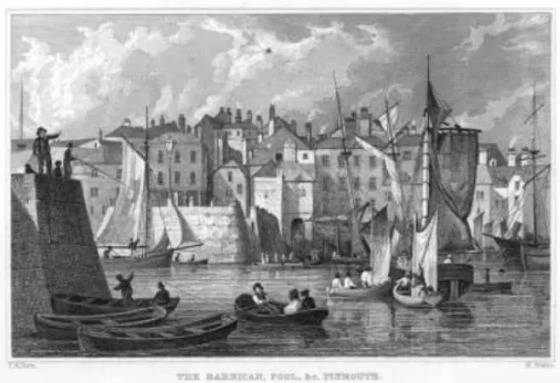
The Barbican, Plymouth
Apart from the trawlers there were ‘sixteen or seventeen’ line fishing boats that each went out with five or six lines to catch ling, cod, whiting, pollock and ‘conger eels in astonishing quantities’ and were manned by two fishermen, and a boy whose job it was to bait and coil in the lines. Line fishing was a less lucrative occupation and the entire crew could expect to earn about two and a half guineas (£2.63) a week. Was Robert a line fisherman or a trawlerman ? There is no evidence to suggest either, but whichever he was, he may have been affected by the problems the fish curers were having with salt supplies and the tax man. Fishing was not a straightforward activity.
Nicholas was about three when the family came to Plymouth, so his only memories would have been of the city, and his whole life would have centred on fishing. He would have watched his father go out every day, would have waited with his mother in bad weather to see whether his boat returned, and he would have seen his mother sell the fish at the market. In 1828 tragedy struck. Robert and his eldest son were in a fishing boat that capsized. they were washed up on shore and ‘found drowned’ a couple of days apart from one another. Nicholas was now the eldest son with four more younger brothers and sisters, so he looked to take over his father’s boat (in fact all three brothers would become fishermen). Their day (and night) was long, so there was little time for anything else. Plymouth was a busy port but events outside fishing would probably have passed the family by. In 1831, Charles Darwin set off in The Beagle on his historic voyage, but the fishing would not have waited for the family to be spectators. But, if they didn’t notice him, Darwin saw the fishermen, writing about them in his journal. He also watched the new breakwater being built about which he said that “Everybody agrees in the Breakwater being as useful as it is a most stupendous work of art” but it was the practicalities of the breakwater that would have interested the Knox family rather than its beauty.
Death of Robert Knox and Son
Nicholas was about three when the family came to Plymouth, so his only memories would have been of the city, and his whole life would have centred on fishing. He would have watched his father go out every day, would have waited with his mother in bad weather to see whether his boat returned, and he would have seen his mother sell the fish at the market. In 1828 tragedy struck. Robert and his eldest son were in a fishing boat that capsized. they were washed up on shore and ‘found drowned’ a couple of days apart from one another.
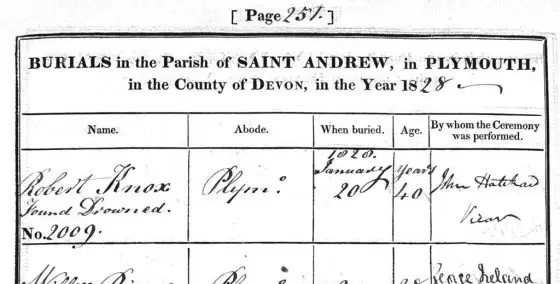
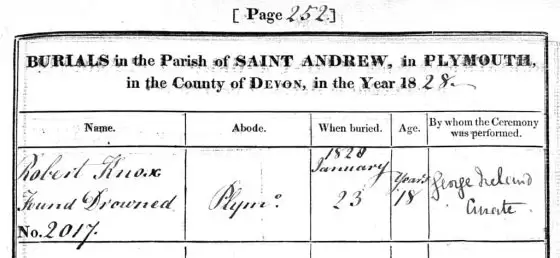
Death of Robert Knox Junior
Nicholas was now the eldest son with four more younger brothers and sisters, so he looked to take over his father’s boat (in fact all three brothers would become fishermen). Their day (and night) was long, so there was little time for anything else. Plymouth was a busy port but events outside fishing would probably have passed the family by. In 1831, Charles Darwin set off in The Beagle on his historic voyage, but the fishing would not have waited for the family to be spectators.
But, if they didn’t notice him, Darwin saw the fishermen, writing about them in his journal. He also watched the new breakwater being built about which he said that “Everybody agrees in the Breakwater being as useful as it is a most stupendous work of art” but it was the practicalities of the breakwater that would have interested the Knox family rather than its beauty.
In 1839 Nicholas married Mary Butler, the daughter of a journeyman tanner, Richard Butler. Although she had been born in Kingsbridge – roughly midway between Brixham and Plymouth – her father’s work had brought him to Plymouth at about the time he remarried. Mary had an elder sister, but her mother had died when Mary was about ten, and John’s second wife was from Plymouth. (Note 2) (Note 3)Tanning was a skilled occupation and required a seven year apprenticeship. Devon was one of the leading counties (only Surrey and Lancashire had more tanners) with a plentiful supply of hides both in the county and coming into the ports from abroad. However, the oak needed to cure the leather was expensive and the Napoleonic War had made it more so. Around Mary’s birth, Richard would have been hit by the triple whammy of high oak prices, the post-war drop in the demand, and the tax on leather goods that the government had introduced in 1812. Large numbers of tanners went bankrupt and it may that Richard moved from Kingsbridge to Plymouth as a result of these pressures. By 1839, though, Mary’s work was very much on fishing rather than leather.
Shortly after the birth of Nicholas and Mary’s first child, Mary Ann, there was another report on the Plymouth fishing industry. (Note 4) By 1843 the number of trawlers had risen to over sixty, there were about forty boats fishing by deep-sea lines and there were several driving boats that caught herring, mackerel and pilchards working as teams. The report is not flattering about the trawlermen, saying that the Plymouth fish markets were supplied mainly by these boats but that the fish were of poor quality, and many were young or spawning, so that a great deal had to be ‘consigned to the manure heap’ whilst, in addition, the fishing stocks were being depleted. It also lists all the different types of fishing methods and nets, drawing attention to the damage each could do to the birds, such as guillemots, who tried to eat the fish; and the fish themselves. One senses that the concerns were not focused on the animal welfare but undoubtedly the authorities were aware of the waste involved when fishing became large scale.
Robert Knox had by now been dead for a few years (Note 5), but Elizabeth was still well and working in the fish markets. She lived with her three daughters, two unmarried and one married but living at home. New Street (ironically the oldest street in Plymouth) was becoming home to most of the Knox clan and, by the end of the decade, every other house seemed to be occupied by one of the six siblings and their mother. By now Nicholas and Mary had three daughters of their own, but their only son had died of meningitis when he was four and life would not get any better. One daughter, Elizabeth, died in 1851 and the following year Mary herself died. While his elder daughter, Mary Ann, was now twelve and old enough to become a servant, Nicholas’ youngest daughter, Charlotte, was barely four and he can only have continued with his fishing with help from his family. Mary’s father, Richard, was still alive; but his second wife had also died and, in 1851, he married a widow (Note 6) and continued as a journeyman tanner. In 1861, whether by choice or necessity, they were in Cornwall but, when he died in 1869, he was back near his daughter in Plymouth.
Nicholas’ brothers were now successful fishermen, with John on his way to becoming a master mariner and James also doing well, but Nicholas seemed never to recover from the deaths of half his family. Mary Ann remained a servant until she married a mason, John Hine, in 1870; but Charlotte lived with Nicholas for the rest of his life, first with him looking after her, and then with the roles reversed. He continued as a boatman but was finding it increasingly difficult physically. By 1871, at nearly sixty, he still called himself a fisherman, but he was also an invalid, so his contribution to the fishing boat would have been diminished. He and Charlotte had moved to a house a little further north in the city which they shared with eight other families totalling over thirty people, suggesting that life was very difficult.
Charlotte married another fisherman, but continued to look after Nicholas. Her husband would go on to become a master fisherman looking after his own boat, but the fact that the whole family continued to live in a house with thirty other people suggests that the good times were still some way off. Despite the poverty, personal tragedy and physical problems Nicholas struggled on and lived until 1885 when he was well into his seventies. Fortunately he did not live quite long enough to see Mary Ann die young as well, but cannot have died a contented man.
Notes
1. Review of the mercantile, trading and manufacturing state, interests and capabilities of the Port of Plymouth by William Burt;1816
2. It is possible that there were two Richard Butlers. We know that Mary was born in Kingsbridge (Dodbrooke) in 1813 and that she had an elder sister, Grace, who married a Plymouth fisherman. Their father was a tanner (Mary’s marriage certificate lists her father’s occupation as ‘farmer’ but I think this is a misreading of the original). We also know that a Richard Butler,also a tanner, married Ann Vinnecombe in 1824, had four children, and lived in Plymouth; but we cannot prove that he was a widower when he married. This second Richard was also born in Kingsbridge in about 1787. Overall (see also next note) there is a lot of circumstantial evidence linking the two Richards and I have assumed they are the same man.
3. In 1841 John Butler, Richard’s brother – we know about his being a brother from a later census – is listed in the census as John Butland. If this is evidence that Butler/Butland was interchangeable, then there is a marriage between a Richard Butland and Grace Merdon in 1790 in Ashburton which would be relevant. They went on to have Sarah (1793) and Grace (1795) before conveniently stopping just before Richard and Grace Butler had John in the same place. Richard junior’s baptisms remains elusive, (and might before his ‘parents’ married in 1790, so he could be illegitimate) but there is a marriage between Richard Butland and Mary Lutterall in Ashburton in 1808, and a baptism for Grace later in the year, which would be very relevant.
4. An account of the fishes and fisheries of Devon and Cornwall by J.C.Bellamy;1843
5. Nicholas’ marriage certificate from 1839 does not say that his father was dead, but that is not unusual. There is no reference to his death in the indices from 1837 and he not in the 1841 census
6. Richard’s third wife, Eliza Jones, was christened Eliza Jones and had a child (Janetta) as Eliza Nathan, so was on at least her third husband when she married Richard.